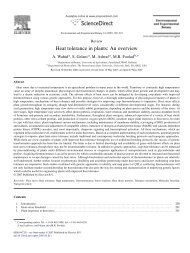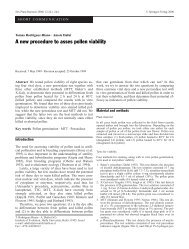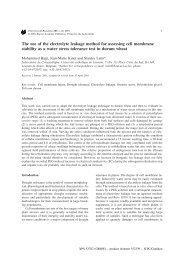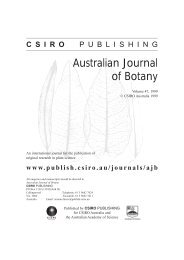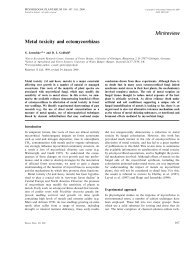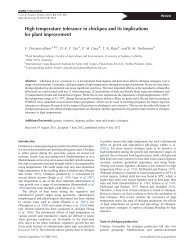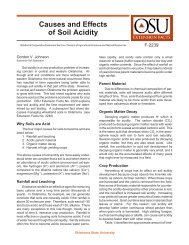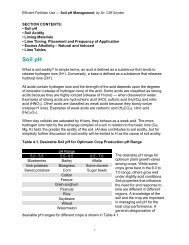Australian Trees for the Rehabilitation of Waterlogged and Salinity ...
Australian Trees for the Rehabilitation of Waterlogged and Salinity ...
Australian Trees for the Rehabilitation of Waterlogged and Salinity ...
You also want an ePaper? Increase the reach of your titles
YUMPU automatically turns print PDFs into web optimized ePapers that Google loves.
698 D. T. Bell<br />
environmental problem in all semi-arid <strong>and</strong> arid regions <strong>of</strong> <strong>the</strong> world (McKell et al. 1986;<br />
Dudal <strong>and</strong> Purnell 1986). Redressing <strong>the</strong> problem requires <strong>the</strong> combined knowledge <strong>and</strong><br />
cooperation <strong>of</strong> hydrologists, engineers, ecologists <strong>and</strong> politicians.<br />
Considerable progress has been made in underst<strong>and</strong>ing <strong>the</strong> hydrological parameters involved<br />
in <strong>the</strong> breakdown <strong>of</strong> <strong>the</strong> soil–salt–water balance in de<strong>for</strong>ested catchments. Hydrological models<br />
<strong>of</strong> Sivapalan et al. (1996a, 1996b, 1996c) have effectively predicted changes in water <strong>and</strong> salt<br />
stores from catchments in south-western Western Australia by considering <strong>the</strong> rainfall input, <strong>the</strong><br />
evapotranspiration output <strong>and</strong> <strong>the</strong> water fluxes <strong>of</strong> three soil-water stores: a near-stream perched<br />
aquifer system; a deeper, permanent groundwater system; <strong>and</strong> an intermediate, unsaturated<br />
infiltration store. In uncleared vegetation, evapotranspiration typically accounts <strong>for</strong> more than<br />
75% <strong>of</strong> rainfall. Williamson et al. (1987) estimated transpiration to be about 75–80% <strong>of</strong> annual<br />
rainfall, with ano<strong>the</strong>r 15% related to interception loss. Sharma (1984) estimated that<br />
interception <strong>and</strong> transpiration in Eucalyptus marginata <strong>for</strong>ests account <strong>for</strong> nearly 90% <strong>of</strong> annual<br />
rainfall. In woodl<strong>and</strong>s near Perth, nearly all <strong>the</strong> annual rainfall gains were balanced by annual<br />
evapotranspirational losses (Dodd <strong>and</strong> Bell 1993a, 1993b).<br />
Year-round water utilisation is an attribute <strong>of</strong> native vegetation, while agricultural crop<br />
water use is seasonally restricted. Carbon et al. (1980) found that <strong>the</strong> deep-rooted, evergreen,<br />
eucalypt vegetation <strong>of</strong> Western Australia effectively exploits a very large soil volume,<br />
transpiring water from deep in <strong>the</strong> soil pr<strong>of</strong>ile, especially <strong>the</strong> soil water at <strong>the</strong> fringe <strong>of</strong> <strong>the</strong><br />
deeper, permanent groundwater table. As a result, <strong>the</strong> overstorey trees maintain a substantial<br />
transpiration rate throughout <strong>the</strong> arid, Mediterranean-climate summer in spite <strong>of</strong> severely<br />
limiting soil moisture in <strong>the</strong> upper soil layers. Sharma et al. (1987) reported that at least 20%<br />
<strong>of</strong> summer evapotranspiration totals are derived from depths greater than 6 m. There<strong>for</strong>e, any<br />
major alteration in leaf area index, usually about 2.0 in jarrah <strong>for</strong>ests (Bettenay et al. 1980),<br />
will cause major changes in <strong>the</strong> flux <strong>of</strong> water to <strong>the</strong> atmosphere. Williamson et al. (1987)<br />
measured a four-fold increase in streamflow following complete clearance <strong>of</strong> <strong>the</strong> <strong>for</strong>est,<br />
average streamflow changing from 10% <strong>of</strong> rainfall under native <strong>for</strong>est to more than 30%<br />
several years after clearing.<br />
The redressing <strong>of</strong> <strong>the</strong> problem <strong>of</strong> excess catchment groundwater, usually with marked<br />
salinities, is now being accomplished in Australia <strong>and</strong> overseas by re-establishing catchment<br />
leaf area index with plantings <strong>of</strong> trees <strong>and</strong> shrubs (Sch<strong>of</strong>ield 1992). Tree-growing systems<br />
can assist in <strong>the</strong> redevelopment <strong>of</strong> salt <strong>and</strong> water balance in both recharge <strong>and</strong> discharge<br />
zones <strong>of</strong> catchments. In recharge zones, tree-growing systems can include <strong>the</strong> use <strong>of</strong><br />
commercial species to assist with water-table control by utilising soil water in <strong>the</strong> unsaturated<br />
infiltration zone water store. Species <strong>of</strong> commercial value which maximise water use would<br />
be <strong>the</strong> preference <strong>for</strong> tree plantings in this zone, although species with aes<strong>the</strong>tic values <strong>and</strong><br />
those that produce shade <strong>and</strong> shelter <strong>for</strong> associated plants <strong>and</strong> animals have <strong>the</strong>ir place in<br />
repaired <strong>Australian</strong> l<strong>and</strong>scapes. In <strong>the</strong> near-stream, perched, aquifer system <strong>and</strong> to utilise<br />
deeper, subsurface water stores, trees with tolerance <strong>of</strong> waterlogging <strong>and</strong> salinity are<br />
required. This review surveys <strong>the</strong> species with <strong>the</strong> potential to rehabilitate <strong>the</strong>se damaged<br />
agricultural catchments, concentrating on <strong>the</strong> ecophysiological attributes that allow <strong>the</strong>m to<br />
survive <strong>and</strong> function in <strong>the</strong>se environments that have been altered by humans.<br />
Species Requirements <strong>and</strong> Capabilities<br />
Infiltration Zone Species<br />
Upl<strong>and</strong> recharge <strong>and</strong> infiltration zones in damaged agricultural catchments should be<br />
restored to native plant communities or planted with <strong>Australian</strong> commercial tree species<br />
crops. Greenwood et al. (1985) found that <strong>the</strong> annual evapotranspiration from plantations <strong>of</strong><br />
Eucalyptus globulus, E. cladocalyx <strong>and</strong> E. maculata was up to seven times that from grazed<br />
pasture l<strong>and</strong>scapes. In addition to <strong>the</strong>ir role in water use in recharge zones, genotypes <strong>of</strong><br />
<strong>Australian</strong> species can produce on-farm incomes in s<strong>of</strong>t-wood <strong>and</strong> hard-wood timbers, paper



